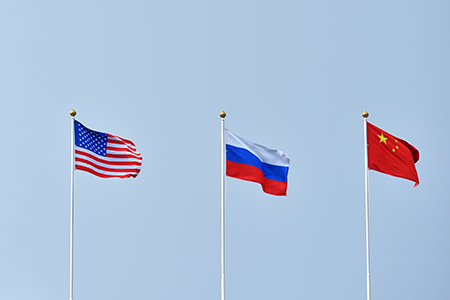"I greatly appreciate your very swift response, and your organization's work in general. It's a terrific source of authoritative information."
Forging New Pathways for Disarmament Diplomacy
September 2024
By Daryl G. Kimball
For more than a decade, the five nuclear-armed states recognized under the nuclear Nonproliferation Treaty (NPT) have failed to engage in constructive nuclear disarmament and risk reduction diplomacy. Instead, they are spending tens of billions of dollars annually to modernize, upgrade, and in some cases expand their deadly arsenals.

To get back on track, leaders in Beijing, Moscow, and Washington will need to deploy new, more creative approaches to put in place new constraints and guardrails against a dangerous arms race in which everyone loses.
Although the 2010 New Strategic Arms Reduction Treaty (New START) will expire in 2026, Russian President Vladimir Putin has refused to engage with the Biden administration on its 2023 offer to discuss “without precondition” a new nuclear arms control framework to prevent an unconstrained nuclear arms race. Putin’s excuse is that such a dialogue would not be fruitful as long as Washington continues to support Ukraine as it defends itself against Russian aggression.
Meanwhile, China is building up its smaller but deadly nuclear force now estimated to consist of some 310 warheads on long-range missiles, with perhaps 500 missiles in total. Unfortunately, China’s leaders also have rejected U.S. offers for follow-up talks on nuclear risk reduction and arms control issues, citing ongoing U.S. arms sales to Taiwan.
If Russia and the United States exceed New START limits, it would destabilize their mutual balance of nuclear terror, strain the already costly and behind-schedule U.S. nuclear modernization program, and prompt China to accelerate its own nuclear buildup. Such an action-reaction cycle would be madness.
What can be done? First, in the coming weeks, U.S. President Joe Biden and whoever is the next president-elect should reaffirm U.S. support for negotiating a new nuclear arms control framework with Russia. Because such a deal would be difficult to hammer out and take time, the president should propose that Washington and Moscow conclude a simple, bilateral understanding promising that neither side shall increase the number of deployed strategic nuclear warheads beyond the New START limits. This would remain in force until they can conclude a more comprehensive, durable framework to limit and reduce their deadly nuclear arsenals.
As long as Russia and the United States agree to cap their strategic deployed nuclear arsenals and work to negotiate a new nuclear arms reduction framework, Washington, along with leading non-nuclear-weapon states, should call on China, France, and the United Kingdom to freeze the overall size of their nuclear arsenals and negotiate a ban on fissile material production for weapons.
Second, if China continues to decline talks with Washington on nuclear matters, it has an even greater responsibility to elevate the underperforming P5 consultation process, the dialogue on nuclear risk reduction involving the NPT’s five nuclear-weapon states, that has been underway since 2010.
China, which now chairs the group, is in a unique position to launch an ambitious program to increase the frequency of these meetings; raise the level of participation; expand the topics of discussion, including exchanges on nuclear postures and joint pledges not to use nuclear weapons first; and build on past success.
For example, the five states could expand on their 2022 joint declaration that “nuclear war cannot be won and must never be fought” by adopting a statement in the 1973 U.S.-Soviet Agreement on the Prevention of Nuclear War that pledges that the nuclear powers will “refrain from the threat or use of force against the other party, against the allies of the other party and against other countries.”
In the context of these discussions, senior U.S. diplomats should clarify that they will not seek and will not pursue an increase in the size or diversity of the U.S. nuclear arsenal as long as Russia continues to respect the New START ceilings and China does not expand its strategic nuclear arsenal significantly, which is not likely until the year 2030 or later.
China could explain what is driving its buildup and clarify its nuclear modernization plans. Such an approach would help Beijing avoid worst-case assumptions about its intentions and the potential for a three-way arms race.
Finally, leading non-nuclear-weapon states not only need to press the United States and Russia to engage on nuclear arms control and push China to halt its nuclear buildup. They seriously should consider launching a new initiative that would lead to a series of high-level nuclear disarmament summits involving a group of 20 to 30 leaders from nuclear- and non-nuclear-weapon states. If designed properly, such an approach could help overcome existing obstacles of disarmament diplomacy, increase pressure for action, and complement existing forums designed to advance progress toward the elimination of nuclear weapons.
If the world is to halt and reverse the cycle of spiraling nuclear tensions, it will require new, bolder global leadership and sustained public pressure in the weeks, months, and years ahead.
